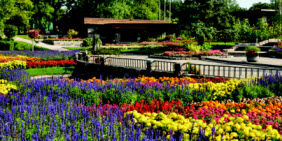By Dorothy Dobbie
We’ve been living in a chemical world where it’s been hard to avoid pesticides, insecticides, herbicides and every other kind of ‘cides you can think of. They show up in your food and your living environment and then in your body – not to mention the bodies of our kids and pets. It’s enough to make a gardener mighty cautious when it comes to dealing with plant disease and pests by using a liberal dose of something off the garden centre shelf.
Ted Perry had it right when he wrote that Chief Seattle said that all things are connected and that whatever befalls man befalls the earth. We are companions and knowing how best to live together as plants and animals, in a balanced way, is the best plan for a beautiful tomorrow.
Long before the chemical world was born, people raised healthy gardens. When cyclical infestations of disease or insects occurred, the response was to plant something else for the duration. Eventually, rotational farming methods became the answer for problems associated with vast acreages of monoculture crops, but the same sensible habits can help your garden.
Diversity of plant material is important. Over time, pathogens -- fungi or parasitic nematodes -- will build up around plant populations. In the natural world, plants deal with this by using strategies for the dispersal of their seeds to new locations, but in gardens we discourage this through constant deadheading and other practices consistent with our desire for order. Planting a single variety over and over in the same place is a dangerous practice. Think of the potato famine in Ireland in the 1840s, when a fungal infection attacked the single potato species grown and devastated crops virtually overnight.
Our tidiness habits also work against us. Most believe that eventually “the soil just wears out”, depleted of all its nutrients, but think of the vast prairies or forests that have existed for thousands of years. While the dense plant life certainly drew quantities of nutrients from the top soils, they were also continuously returning those nutrients to the soil as dropping leaves and decaying plants.
Lesson Number One
Return plant material to plant beds, whether as green material or as compost. The soil has unlimited nutrition as long as the plants can access it – the mineral content is always there, deep in the earth. But continued clearing of dying garden material can speed depletion of nutrients that are there in the top seven inches of soil where most garden plants place their roots. Returning foliage to the soil also returns phosphorus, potassium, nitrogen and all the other nutrients that were taken up as building blocks of the stems and leaves in the first place. At the same time, plant material will improve the structure of the soil.
Lesson Number Two
Rotate your crops in a vegetable garden or move plants from time to time in a flower garden. A key reason for this is to avoid the build-up of pathogens that will collect around a certain species, in effect “poisoning” the soil, but a secondary reason is that some plants reach deeper into the soil than others, accessing nutrients from a new source. Grow nitrogen-fixing plants – leguminous plants such as peas, lupines, beans, baptisia or sweet peas, even caragana -- to help other plants access nitrogen the natural way. Clover also has nitrogen-fixing properties.
Lesson Number Three
Don’t make your yard a chemical dump. Sometimes gardeners get a little overenthusiastic about “cleaning up the soil” by laying down countless artificial remedies to rid the garden of pests. Instead, avoid chemical interference as much as possible by following lessons numbers one and two. If a particular insect is a problem, then introduce plants that can help by either acting as an attractive alternative and trap the bugs before they can get to your prized varieties or grow plants that will produce a natural repellent.
Sure, clean up those weeds, but don’t worry if one or two survive. Dandelions dredge up vast amounts of nutrition from deeper in the soil. Clover fixes nitrogen in your lawn. Dead nettle repels the potato bug. Grown near aromatic herbs, stinging nettles increase the aromatic oils by up to 80 percent. And of course we all know that basil loves tomatoes, but tomatoes also like bee balm. The more we know of these relationships, the better natural gardeners we’ll become.
Dorothy Dobbie is the founder of Manitoba Gardener magazine. localgardener.net. Her weekly garden show can be heard on CJNU 93.7FM at 8:00 on Sunday mornings.



